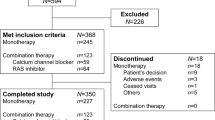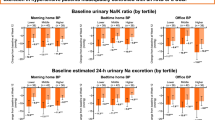Abstract
Fixed combinations of calcium channel blockers and angiotensin converting enzyme inhibitors represent an alternative to diuretic-based combination therapy. The aim of the present study was to compare the antihypertensive efficacy of the combination enalapril 10 mg/nitrendipine 20 mg (E/N) vs losartan 50 mg/hydrochlorothiazide 12.5 mg (L/H), assessed by 24-h ambulatory blood pressure monitoring. This multicentre, double-blind, parallel study included 97 hypertensive patients (office diastolic blood pressure (DBP) 90–109 mmHg and daytime DBP >85 mmHg). After a 2- to 3-week period of single-blind placebo, they were randomized to receive double-blind treatment with E/N (n=48) or L/H (n=49) for a 4-week period. The primary outcome measure was the difference in 24-h DBP reduction between treatments from randomization to the end of the double-blind period. Secondary efficacy variables included differences in 24-h systolic (S) BP reduction, daytime, night-time and office SBP and DBP reduction, proportion of responders and controlled patients, trough-to-peak ratio and smoothness indexes. Safety was assessed by the proportion of patients with adverse events and the detection of laboratory abnormalities. No significant differences were observed in the primary outcome measure. The group receiving E/N tended to show greater reductions in most measures (24 h, daytime and office SBP and DBP) and higher BP control rates, but only the difference in the rate of office SBP control (<140 mmHg) reached statistical significance (42.2 vs 22.4%; P=0.048). The trough-to-peak ratios and smoothness indexes were similar in both groups. The incidence of adverse events related to the treatment was 27.1% (95% CI 14.5–39.6%) in E/N-treated patients and 14.3% (95% CI 4.5–45.8%) in the L/H group, but differences were not significant. The kind of event more frequently observed were flushing and headache in E/N, and dizziness and asthenia in L/H; all observed adverse events were mild. We conclude that E/N and L/H have a similar antihypertensive efficacy, assessed by office or ambulatory blood pressure monitoring. E/N achieved a significantly higher office SBP control rate, but this was accompanied by an apparently higher proportion of mild adverse events.
This is a preview of subscription content, access via your institution
Access options
Subscribe to this journal
Receive 12 digital issues and online access to articles
$119.00 per year
only $9.92 per issue
Buy this article
- Purchase on Springer Link
- Instant access to full article PDF
Prices may be subject to local taxes which are calculated during checkout


Similar content being viewed by others
References
Chobanian AV et al. The Seventh Report of the Joint National Committee on Prevention, Detection, Evaluation, and Treatment of High Blood Pressure. The JNC 7 Report. JAMA 2003; 289: 2560–2571.
Messerli FH . Combinations in the treatment of hypertension: ACE inhibitors and calcium antagonists. Am J Hypertens 1999; 12: S86–S90.
Menard J, Bellet M . Calcium antagonists—ACE inhibitors combination therapy: objectives and methodology of clinical development. J Cardiovasc Pharmacol 1993; 21(Suppl 2): S49–S54.
Holzgreve H . Combination of calcium antagonists and ACE inhibitors in hypertension. J Cardiovasc Pharmacol 1997; 30(Suppl 1): S24–S29.
Hansson L et al. Effects of intensive blood-pressure lowering and low-dose aspirin in patients with hypertension: principal results of the hypertension optimal treatment (HOT) randomised trial. Lancet 1998; 351: 1755–1762.
Brown MJ et al. Morbidity and mortality in patients randomised to double-blind treatment with a long-acting calcium-channel blocker or diuretic in the International Nifedipine GITS study: intervention as a goal in hypertension treatment (INSIGHT). Lancet 2000; 356: 366–372.
Hansson L et al. Randomised trial of effects of calcium antagonists compared with diuretics and β-blockers on cardiovascular morbidity and mortality in hypertension: the Nordic Diltiazem (NORDIL) study. Lancet 2000; 356: 359–365.
Hansson L et al. Randomised trial of old and new antihypertensive drugs in elderly patients: cardiovascular mortality and morbidity the Swedish Trial in Old Patients with Hypertension-2 study. Lancet 1999; 354: 1751–1756.
Staessen JA et al for the Systolic Hypertension in Europe (Syst-Eur) Trial Investigators. Randomised double-blind comparison of placebo and active treatment for older patients with isolated systolic hypertension. Lancet 1997; 350: 757–764.
Blood Pressure Lowering Trialist Collaboration. Effects of ACE inhibitors, calcium antagonists, and other blood-pressure-lowering drugs: results of prospectively designed overviews of randomised trials. Lancet 2000; 355: 1955–1964.
Staessen JA, Wang JG, Thijs L . Cardiovascular protection and blood pressure reduction: a meta-analysis. Lancet 2001; 358: 1305–1315.
Gradman AH et al. Combined enalapril and felodipine extended release (ER) for systemic hypertension. Am J Cardiol 1997; 79: 431–435.
Messerli FH, Oparil S, Feng Z . Comparison of efficacy and side effects of combination therapy og angiotensin-converting enzyme inhibitor (benazepril) with calcium antagonist (either nifedipine or amlodipine) versus high-dose calcium antagonist monotherapy for systemic hypertension. Am J Cardiol 2000; 86: 1182–1187.
Weir MR, Rosenberger C, Fink JC . Pilot study to evaluate a water displacement technique to compare effects of diuretics and ACE inhibitors to alleviate lower extremity edema due to dihydropiridine calcium antagonists. Am J Hypertens 2001; 14: 963–968.
Guidelines Committee. 2003 European Society of Hypertension—European Society of Cardiology guidelines for the management of arterial hypertension. J Hypertens 2003; 21: 1011–1053.
European Medicines Agency. Committee on Proprietary Medicinal Products. Note for Guidance on Fixed Combination Medicinal Products: CPMP/EWP/240/95.
European Medicines Agency. Committee on Proprietary Medicinal Products. Note for Guidance on Clinical Investigation of Medicinal Products in the Treatment of Hypertension: CPMP/EWP/138/95.
Roca-Cusachs A et al. Nitrendipine and enalapril combination therapy in mild to moderate hypertension: assessment of dose–response relationship by a clinical trial of factorial design. J Cardiovasc Pharmacol 2001; 38: 840–849.
Roca-Cusachs A . Efficacy of a fixed dose combination of enalapril/nitrendipine in patients not controlled with enalapril or nitrendipine monotherapy. Results of pooled analysis of two studies: ENEAS-1 and ENEAS-2. Am J Hypertens 2002; 15: 48A (abstract).
Mancia G, Di Rienzo M, Parati G . Ambulatory blood pressure monitoring use in hypertension research and clinical practice. Hypertension 1993; 21: 510–524.
Omboni S, Parati G, Zanchetti A, Mancia G . Calculation of trough:peak ratio of antihypertensive treatment from ambulatory blood pressure: methodological aspects. J Hypertens 1995; 13: 1105–1112.
Parati G et al. The smoothness index: a new, reproducible and clinically relevant measure of the homogeneity of the blood pressure reduction with treatment for hypertension. J Hypertens 1998; 16: 1685–1691.
Joint National Committee on Prevention, Detection, Evaluation and Treatment of High Blood Pressure. The sixth report of the Joint National Committee on Prevention, Detection, Evaluation and Treatment of High Blood Pressure. Arch Intern Med 1997; 157: 2413–2446.
Sociedad Española de Hipertensión-Liga Española para la Lucha contra la Hipertensión Arterial. Guía sobre el diagnóstico y el tratamiento de la hipertensión arterial en España 2002. Hipertensión 2002; 19(Suppl 3): 34–41.
The ALLHAT Officers and Coordinators for the ALLHAT Collaborative Research Group. Major outcomes in high-risk hypertensive patients randomised to angiotensin-converting enzyme inhibitor or calcium channel blocker vs diuretic. The Antihypertensive and Lipid-Lowering Treatment to Prevent Heart Attack Trial (ALLHAT). JAMA 2002; 288: 2981–2997.
Dahlöf B et al, for the LIFE study group. Cardiovascular morbidity and mortality in the Losartan Intervention For Endpoint reduction in hypertension study (LIFE): a randomized trial against atenolol. Lancet 2002; 359: 995–1003.
Mancia G, Parati G . Ambulatory blood pressure monitoring and organ damage. Hypertension 2000; 36: 894–900.
Mancia G et al. Lack of placebo effect on ambulatory blood pressure. Am J Hypertens 1995; 8: 311–315.
Trazzi S et al. Reproducibility of non-invasive and intra-arterial blood pressure monitoring: implications for studies on antihypertensive treatment. J Hypertens 1991; 9: 115–119.
Staessen JA et al. Predicting cardiovascular risk using conventional vs ambulatory blood pressure in older patients with systolic hypertension. JAMA 1999; 282: 539–546.
Pickering T . Recommendations for the use of home (self) and ambulatory blood pressure monitoring: American Society of Hypertension ad hoc Panel. Am J Hypertens 1996; 9: 1–11.
Kario K et al. Nocturnal fall in blood pressure and silent cerebrovascular damage in elderly hypertensive patients: advanced silent cerebrovascular damage in extreme dippers. Hypertension 1996; 27: 130–135.
Acknowledgements
The study was financed by Grupo Vita.
Author information
Authors and Affiliations
Corresponding author
Rights and permissions
About this article
Cite this article
de la Sierra, A., Gil-Extremera, B., Calvo, C. et al. Comparison of the antihypertensive effects of the fixed dose combination enalapril 10 mg/nitrendipine 20 mg vs losartan 50 mg/hydrochlorothiazide 12.5 mg, assessed by 24-h ambulatory blood pressure monitoring, in essential hypertensive patients. J Hum Hypertens 18, 215–222 (2004). https://doi.org/10.1038/sj.jhh.1001655
Received:
Revised:
Accepted:
Published:
Issue Date:
DOI: https://doi.org/10.1038/sj.jhh.1001655
Keywords
This article is cited by
-
The benefits of angiotensin-converting enzyme inhibitors/angiotensin II receptor blockers combined with calcium channel blockers on metabolic, renal, and cardiovascular outcomes in hypertensive patients: a meta-analysis
International Urology and Nephrology (2018)
-
Combination Therapy in Hypertension
Advances in Therapy (2013)
-
Effect of non-drug interventions on arterial properties determined from 24-h ambulatory blood pressure measurements
Hypertension Research (2011)
-
Combination therapy in hypertension: An update
Diabetology & Metabolic Syndrome (2010)
-
Combination Therapy as First-Line Treatment for Hypertension
American Journal of Cardiovascular Drugs (2009)



